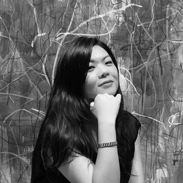Market
How London Became a Launch Pad for Africa’s Booming Art Market
An increasing number of firms dedicated to African art are setting up shop in London.
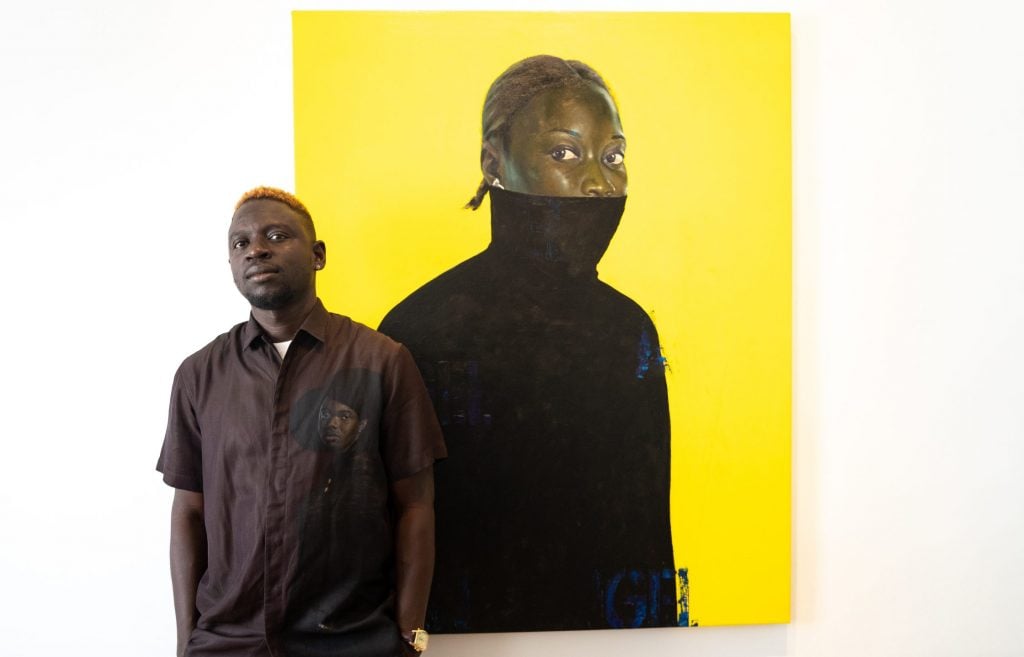
On a recent weekday morning, some two dozen smartly dressed art enthusiasts gathered at Tate Modern before its doors opened for a private tour of the expansive solo exhibition of South African visual activist and photographer Zanele Muholi.
The intimate event marked the launch of Strauss and Co’s Art Club London, an extension of the South African auction house’s activities to widen their footprint in the U.K. capital, ahead of the busy Frieze week. It is one of several new firms dedicated to art from the African continent that has launched in London recently and for good reason: The market for African art in the U.K. has been growing steadily, despite global downturn and an embattled business landscape post-Brexit.
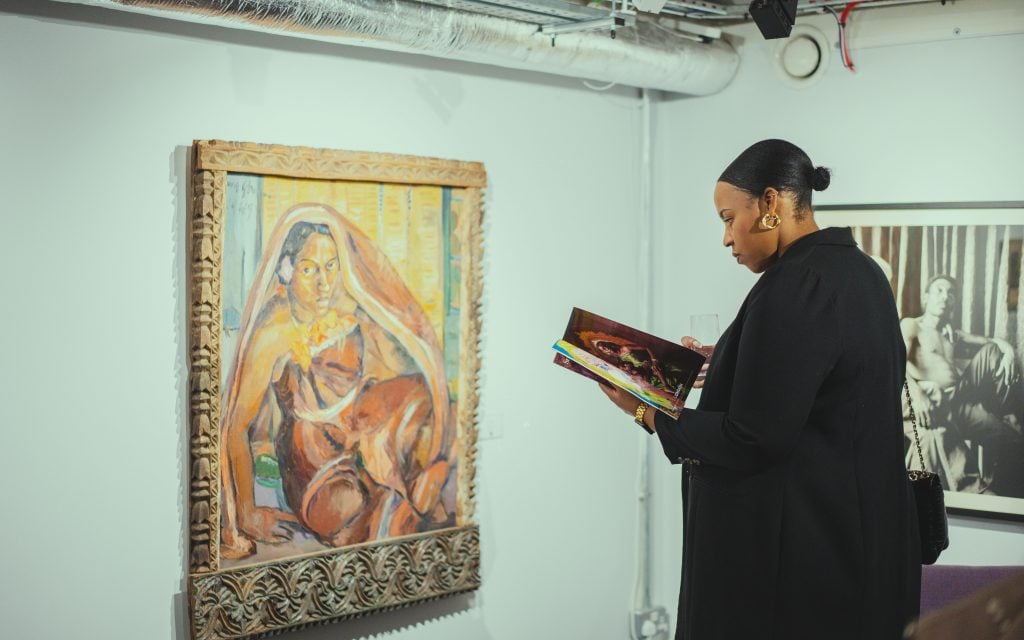
Opening night of Strauss and Co.’s exhibition “Looking Towards Freedom: Womxn Artists from Africa” on October 8, 2024. Photo: Chuko Cribb | Africa No Filter.
With its long history as a cultural center for international artists, businesses, and collectors, London remains a desirable platform for African art, noted Kate Fellens, the international business development director of Strauss and Co. She credits 1-54 Contemporary African Art Fair, the 12th edition of which runs through October 13. Since its launch in 2013, the city has quietly established itself “as a center for African and Afro-diasporic art,” Fellens said.
What the Data Says
Data drawn from the Artnet Price Database shows that the global total sales value of African art at auction in the genres of Modern, Post-War, contemporary, and ultra-contemporary totaled $110.3 million in 2021. It peaked at $114 million in 2022—a 3 percent year-on-year increase. In 2023, it fell to $94.6 million, a 17 percent dip from the previous year, roughly in line with the 12.7 percent decline of overall global fine art sales at auction.
But auction sales of African art in London across the same categories took on a slightly different trajectory during the same period of time. The total sales value increased 5 percent between 2021 and 2022, rising from $36.7 million to $38.7 million. Despite global market contraction in 2023 that saw ultra-contemporary sales fall markedly, total African art sales across all genres in London still rose by a small margin, to $39.1 million.
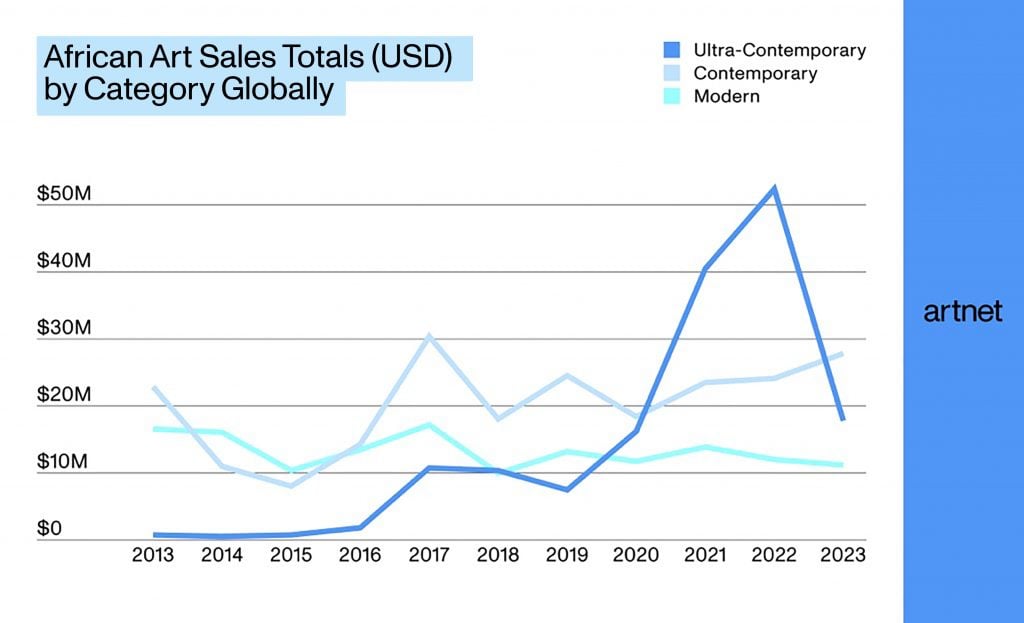
© 2024 Artnet Worldwide Corporation.
Touria El Glaoui, founding director of 1-54, noted that the collector base of art from Africa and its diaspora has grown significantly since the fair was first launched over a decade ago, contributing to the growth of primary and secondary market activities.
“Initially, many of our collectors were based in Europe, but now, we see a far more global interest, with a strong presence from collectors in the Global South and African diaspora,” El Glaoui said ahead of the fair’s return to London’s Somerset House. This year’s edition features more than 60 galleries, including 23 new exhibitors, showcasing works by more over 160 artists. The event coincides with Frieze London, which also includes several exhibitors with spaces in Africa, such as Goodman Gallery from Johannesburg and Blank from Cape Town.
Overcoming Obstacles
El Glaoui observed that one of the biggest hurdles for promoting African art in London, as well as Europe more broadly, was breaking through the dominant Eurocentrism in the art world, “where African art was often sidelined or misrepresented.” The lack of institutional support for contemporary African artists also reduced the visibility of artists, she added.
“But the situation has improved considerably,” El Glaoui noted, citing exhibitions such as “Making a Rukus!,” an exhibition exploring the Black Queer histories opening at Somerset House on October 11 and running through January 19, 2025.
Finding consistent engagement and the cost of staging events and shows in locations with challenging exchange rates for Africa or South Africa have also been major obstacles, noted Fellens of Strauss and Co. The launch of Art Club is one strategy to overcome this issue as it offers both in-person and online events to keep audiences interested.
“It is hard to capture attention in a very busy market,” Fellens said. “Despite people saying they are interested in art from Africa, translating that into action is not always quick, though it has been wonderful to see how attention and support is increasing, so we must stay positive.”
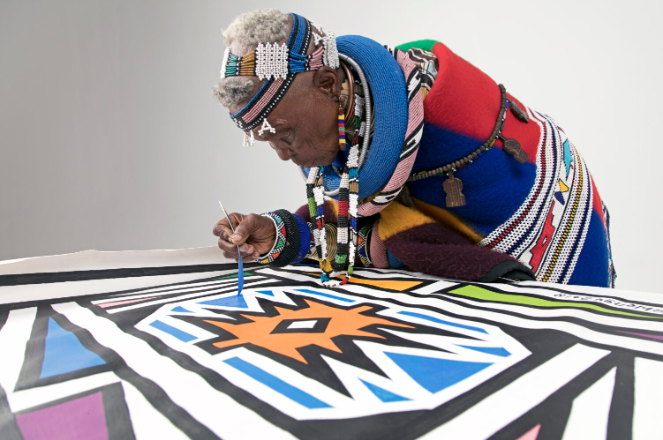
Esther Mahlangu, photo by Clint Strydom, courtesy of The Melrose Gallery.
Collaborating with other industry players has been integral to cultivating a community, according to Fellens. For example, South African artist Esther Mahlangu unveiled Umuntu ngumuntu ngabantu in the garden at Serpentine North on Wednesday. The artist’s first public mural in the U.K., it depicts Ndebele shapes and patterns outlined with a black border across 16 wooden panels.
“Public projects that engage in open spaces will help people to engage with these artists regardless of needing to step into a gallery,” Fellens said. Meanwhile, Strauss and Co. is hosting selling exhibition “Looking Towards Freedom: Womxn Artists from Africa” at Maison Pan near Trafalgar Square from October 7 to 13.
New Business Models
African artists are also taking their careers into their own hands. Nigerian artist Oluwole Omofemi teamed up with his friend Bayo Akande, an entrepreneur who co-founded two radio stations and has experience in talent management, to launch PieceUnique, an agency dedicated to African contemporary art. After a debut exhibition, “Contact Zone,” at London’s Cromwell Place this summer, the agency returns with an autumn program.
PieceUnique will take part in 1-54 for the first time in the Special Projects section with the exhibition “Contact Zone II,” showcasing works created by Omofemi, the London-based textile artist Elfreda Dali, Michael Blebo, a sculptor and painter from Ghana, and Cameroonian painter ANJEL (Boris Anje). All works were produced during the agency’s inaugural artist residency in Ibadan, Nigeria, in September. At the fair, the agency will also unveil its first limited-edition artist-designed collections.
The goal of setting up an agency rather than a gallery to champion African contemporary art was to disrupt the existing model, the agency’s founders noted. Individual artists like those from Africa have long been undervalued can feel vulnerable when they wanted to venture into a bigger art world, Omofemi said, citing his own bad experiences—a dealer did not pay him after taking several of his paintings.
“The dealer was trying to exploit me,” Omofemi said. “I thought, ‘It happened because I did not have an agency to manage and deal with this.'”
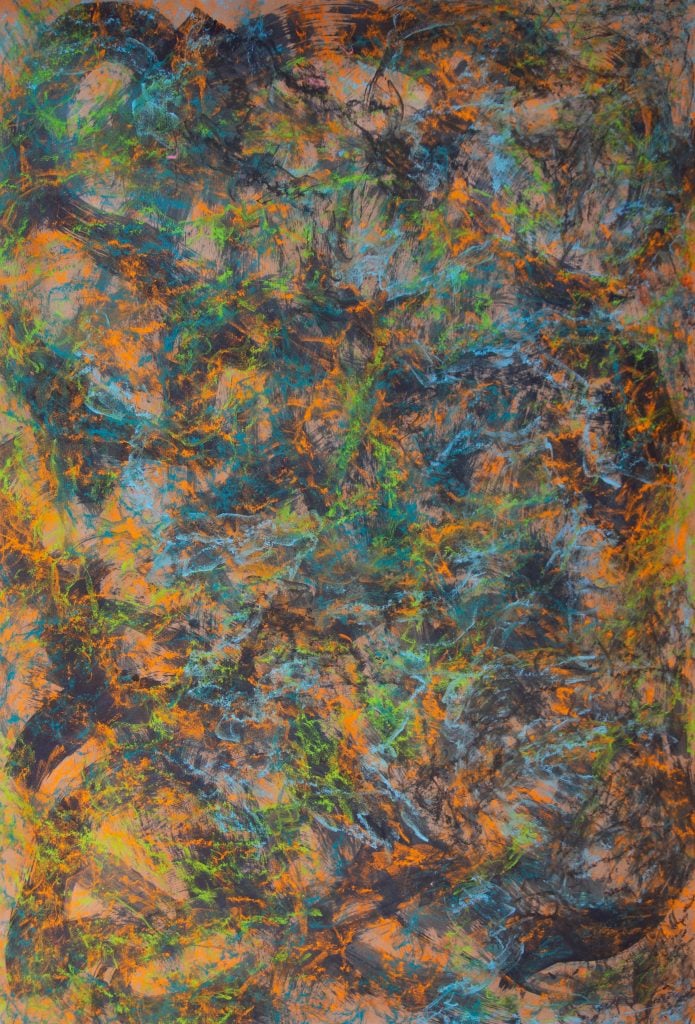
Michael Blebo, Fireflies, (2024). Courtesy the artist and PieceUnique.
“I was shocked to hear that there are no managers in the art world,” said Akande, also a collector. “Musicians have managers. Actors have managers. An author would have a manager. There are all creatives just using different outlets. Why wouldn’t an artist have a manger? There is definitely a gap in the art world.”
PieceUnique acts as an additional layer between artists and galleries, dealers, and institutions from other parts of the world. The agency does not have an exclusive agreement with the artist, according to the founders, but rather, it focuses on helping the artists to realize their vision in all sorts of ways, from artistic creations to personal branding and merchandise.
Expanding the Narrative
Broadening the narrative around African art is the key to the future, and this can be achieved through the discourse of the African diaspora, noted El Glaoui. Building relationships beyond those with African roots will further expand the audience base of art with ties from the continent. London appears to be a rightful meeting point to serve this purpose.
“London’s diverse art scene and global audience make it a prime spot for showcasing African art,” noted the Manila-based collector Timothy Tan, whose collection of African diasporic art was shown in the Metropolitan Museum of Manila last year at the exhibition “Sounds of Blackness,” the country’s first major showcase of art from the continent. “Plus, the city’s galleries and museums are eager to feature diverse voices, offering African artists a prominent stage.”
At 1-54, veteran Chinese dealer Pearl Lam, who has spaces in Hong Kong and Shanghai, will make her debut at the fair with “Terra Mater,” a solo presentation of 12 new tapestry works and 10 sculptures by Nigerian artist Alimi Adewale. The artist will have a solo show with the gallery in Shanghai in 2025.
“The discourse of the African diaspora allows artists to challenge traditional narratives and create a space where different cultural histories intersect,” El Glaoui said. “Looking to the future, I see the work of diaspora artists continuing to expand in significance, not just in Europe but globally.”

